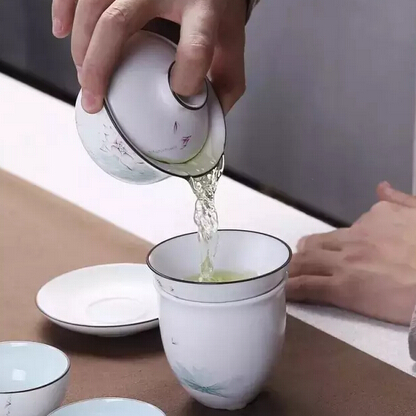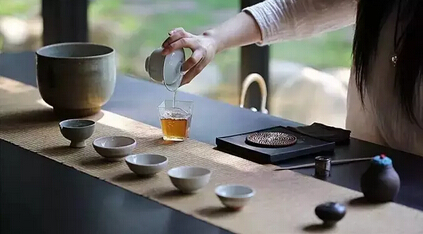Famous tea leaves expert Shi Zhaopeng, in his edited book 'Tea Evaluation and Inspection,' mentions that the aroma and taste of tea are complex, influenced by various factors. Different types and origins of tea have their own unique aromas and flavors.
For example, black tea aroma is often described as "rich" or "fresh and sweet," while green tea aroma is expressed as "fresh and tender" or "clear and fragrant." The unique aroma of teas from different regions is often described as "regional fragrance," such as the "Keemun fragrance" of Keemun black tea.
In short, any unique aroma or taste is a comprehensive reflection of the substances contained in the tea, as well as the result of factors such as variety, cultivation techniques, picking quality, processing methods, and storage.

The nine types of tea aromas:
Based on the quality of fresh leaves, processing methods, and the characteristics of tea aromas, the aroma types are roughly divided into the following nine categories:
1. Hairy aroma type: Fresh leaves with white hairs, tenderness of one bud and one leaf or more, processed normally. The dry tea reveals white hairs, and the unique aroma released during brewing is called hairy aroma. For example, various silver needle teas have a typical hairy aroma, while some Maojian and Maofeng teas have a tender aroma with a hint of hairy aroma.
2. Tender aroma type: Fresh leaves are soft and tender, with one bud and two leaves just unfolding, processed timely and properly. Teas with tender aroma include E Rui, various Maojian, and Maofeng teas.
3. Floral aroma type: Fresh leaves are tender, with one bud and two leaves, processed properly, emitting aromas similar to various flowers. Depending on the sweetness of the floral scent, it can be divided into green floral and sweet floral aromas. Green floral aromas include orchid, gardenia, chloranthus, Milan, and honeysuckle. Sweet floral aromas include magnolia, osmanthus, rose, and crimson glory vine. Floral aroma teas include oolong tea, scented teas, and some green and black teas. Oolong teas like Tieguanyin, Baozhong, Wulong, Phoenix Dancong, Shuixian, Langcai, and Taiwanese oolong have distinct floral aromas. Scented teas have their own floral aromas depending on the type of flowers used. Some green teas, like Tongcheng and Shucheng small orchids, Yongxi Huoqing, and high-grade Shulu, have an elegant orchid aroma. Keemun black tea has a pleasant unique fruity and floral aroma.
4. Fruity aroma type: The tea emits aromas similar to various fruits, such as peach, honey peach, snow pear, bergamot, orange, plum, citron, pineapple, longan, and apple. Northern Fujian oolong and some variety teas belong to this aroma type. Black tea often has an apple aroma.
5. Fresh aroma type: Fresh leaves are tender, with one bud and two or three leaves, processed timely and normally. This aroma type includes fresh, high, pure, clean, and bright aromas. Fresh aroma is a typical characteristic of green tea. Additionally, some lightly piled and insufficiently fired yellow teas, as well as lightly rolled and insufficiently fired oolong teas, also belong to this aroma type.

6. Sweet aroma type: Fresh leaves are tender, with one bud and two or three leaves, processed using black tea methods. Sweet aroma is a typical characteristic of Gongfu black tea. This aroma type includes fresh sweet, sweet floral, dried fruit, sweet jujube, orange, honey, and longan aromas.
7. Roasted aroma type: Fresh leaves are older, with more stems, and are baked at high temperatures during processing, causing caramelization of sugars. This aroma type includes rice cake, high fire, old fire, and crispy rice aromas. Teas of this type include Huangda tea, Wuyi rock tea, and Gulao tea.
8. Aged and mellow aroma type: Fresh leaves are older, with a pile-fermentation aging process during processing. Teas of this aroma type include Guangxi Liubao tea, Pu'er tea, and most compressed teas.
9. Pine smoke aroma type: Teas dried using pine or cypress wood, maple balls, or yellow vine smoke generally have a pine smoke aroma. Teas of this aroma type include small species black tea, Weishan Maojian, Liubao tea, and dark tea.

The fourteen types of tea tastes:
1. Strong and intense type: Made from tender one bud and two or three leaves, with plump buds and thick leaves, rich in taste substances, or using high-quality fresh leaves, processed properly. This type is generally used to describe the taste of green tea, which also has a fresh or roasted chestnut aroma. The brewed leaves are tender, thick, and the appearance is robust. When tasted, it initially has a slight bitterness, then becomes strong but not bitter, astringent but not harsh, with a long and refreshing sweet aftertaste, like eating fresh olives. Teas of this type include Tunlu and Wulu.
2. Strong and robust type: Made from tender, taste-rich fresh leaves or high-quality or large-leaf varieties, processed using black tea methods, with light withering, thorough rolling and cutting, and light fermentation. The taste of broken black tea belongs to this type. "Strong" indicates rich tea soup extracts, sticking to the tongue when sipped. "Robust" refers to strong stimulation, with a sticky feeling initially, followed by strong stimulation. This taste type is typical of high-quality broken black tea.
3. Strong and mellow type: Made from tender fresh leaves, processed properly, the tea soup feels rich in extracts, with strong stimulation and astringency, and a sweet or refreshing aftertaste. Teas of this type include high-quality Gongfu black tea, Maojian, Maofeng, and some oolong teas.
4. Rich and thick type: Made from tender fresh leaves with thick leaves, processed properly, the tea soup feels rich in extracts, with strong stimulation and astringency, and a refreshing aftertaste. Teas of this type include Shulu, Suilu, Shiting green tea, Lingyun white hair, Dianhong, and Wuyi rock tea. Rich and refreshing also belong to this type.
5. Mellow and thick type: Made from high-quality, tender fresh leaves, processed normally, this taste type is found in green, black, and oolong teas. Examples include Huoqing, Maojian, Lushan Yunwu, Shuixian, Wulong, Baozhong, Tieguanyin, Sichuan black tea, Keemun black tea, and some Fujian black teas.
6. Aged and mellow type: Made from relatively tender fresh leaves, with a pile-fermentation aging process during processing. Teas of this type include Liubao tea and Pu'er tea.
7. Fresh and mellow type: Made from tender, fresh leaves, processed timely, using green, black, or white tea methods, the taste is fresh and mellow, with a refreshing aftertaste. Teas of this type include Taiping Houkui, high-grade roasted green tea, Da Bai tea, Xiao Bai tea, high-grade Keemun black tea, and Yihong.

8. Fresh and rich type: Made from highly tender fresh leaves, with thick leaves and plump buds, fresh and rich in extracts, processed timely and properly, the taste is fresh and rich, with a refreshing aftertaste. Teas of this type include Huangshan Maofeng and Mingmei.
9. Fresh and clean type: Made from one bud and one leaf, fresh, processed using black or green tea methods, timely and properly, with a fresh aroma and refreshing taste. Teas of this type include Mengding Ganlu, Biluochun, Yuhua tea, Duyun Maojian, Bailin Gongfu, and various silver needle teas.
10. Sweet and mellow type: Made from tender and fresh fresh leaves, processed carefully and properly, the taste is sweet and mellow. Teas of this type include Anhua Songzhen, Enshi Yulu, white tea, and small-leaf Gongfu black tea. Mellow sweet, sweet and harmonious, and sweet and refreshing also belong to this type.
11. Fresh and light type: Made from tender and fresh fresh leaves, low in polyphenols, catechins, and extracts, slightly high in amino acids, processed normally, the tea soup tastes fresh, tender, and comfortable, with a light taste. Teas of this type include Junshan Yinzhen and Mengding Huangya.
12. Mellow and refreshing type: Made from tender fresh leaves, processed timely and properly, the taste is neither strong nor light, neither bitter nor astringent, with a refreshing aftertaste. Examples include yellow bud tea in the yellow tea category and general medium-high-grade Gongfu black tea.
13. Mellow and harmonious type: The taste is not bitter or astringent but has thickness, with a mild and weak aftertaste. Examples include Xiangjian and Liubao tea in the dark tea category and medium-grade Gongfu black tea.
14. Mild type: Made from older fresh leaves, with more than half of the buds and leaves aged, processed normally. Many teas belong to this type, including medium and low-grade black, green, oolong, and yellow teas, and medium-grade dark teas. In addition to a mild, sweet, and non-bitter taste, teas of this type have other characteristics, such as red soup and low aroma for black tea; yellow-green or orange-yellow color and mixed yellow-green brewed leaves for green tea; orange-yellow or orange-red soup color and mixed brewed leaves for oolong tea; deep yellow soup color and relatively yellow and dark brewed leaves for yellow tea; and pine smoke aroma for dark tea.